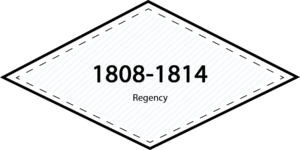
“The Empire Age”
French & worldwide influence on fashion, with continued fondness for the ancient past


—— THE ERA IN BRIEF ——
As new lands are discovered & others exchanged by empirical hands, the everyday woman continued to court the ancient past. Napoleon & the French continued to influence World Order & that of the fashion world through modifications to the Regency style where women would start to cover up to become the bell shaped & fur wrapped women of Scrooge’s “Christmas Past”.

—— PORTRAITS OF REAL WOMEN FROM THE ERA ——
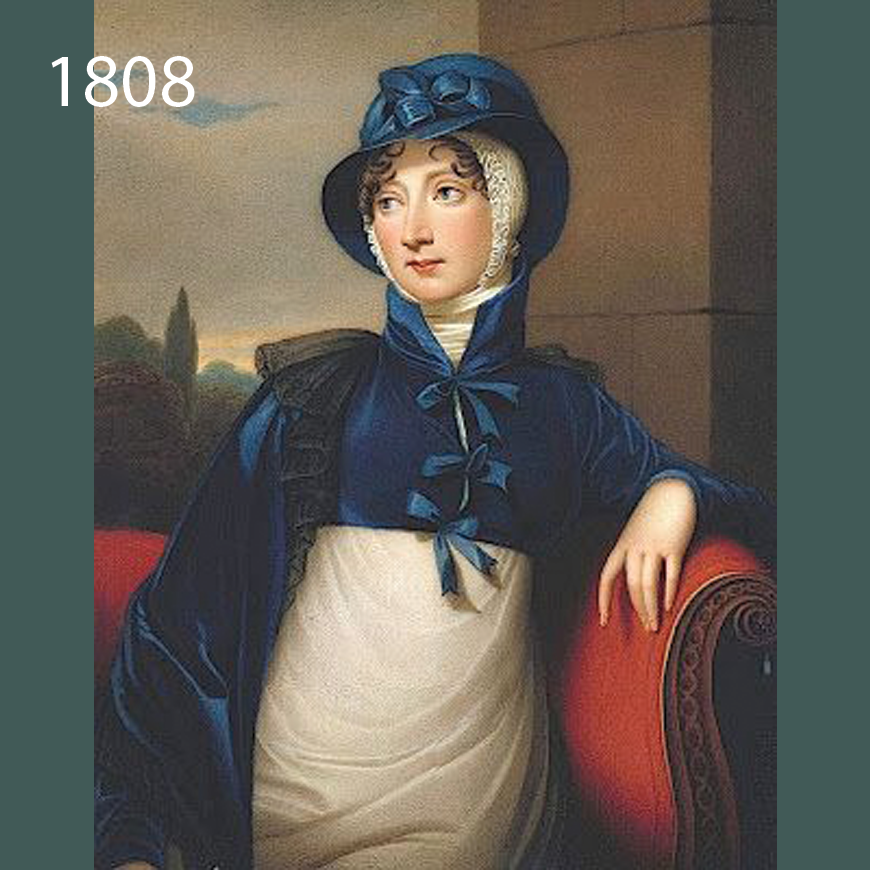
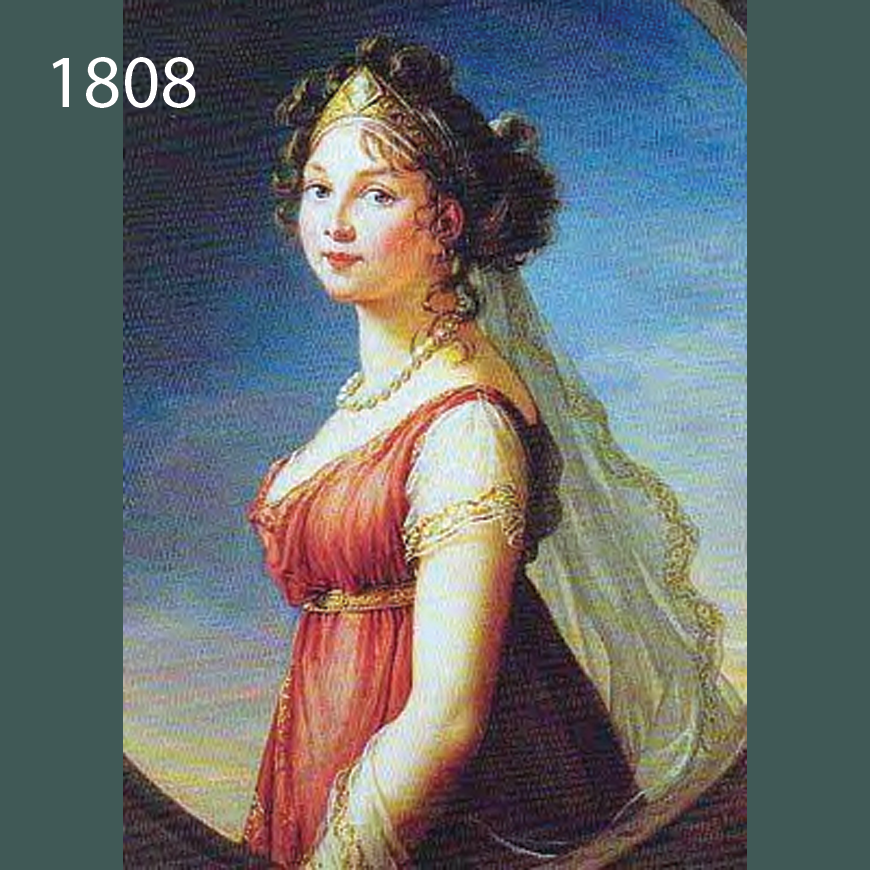
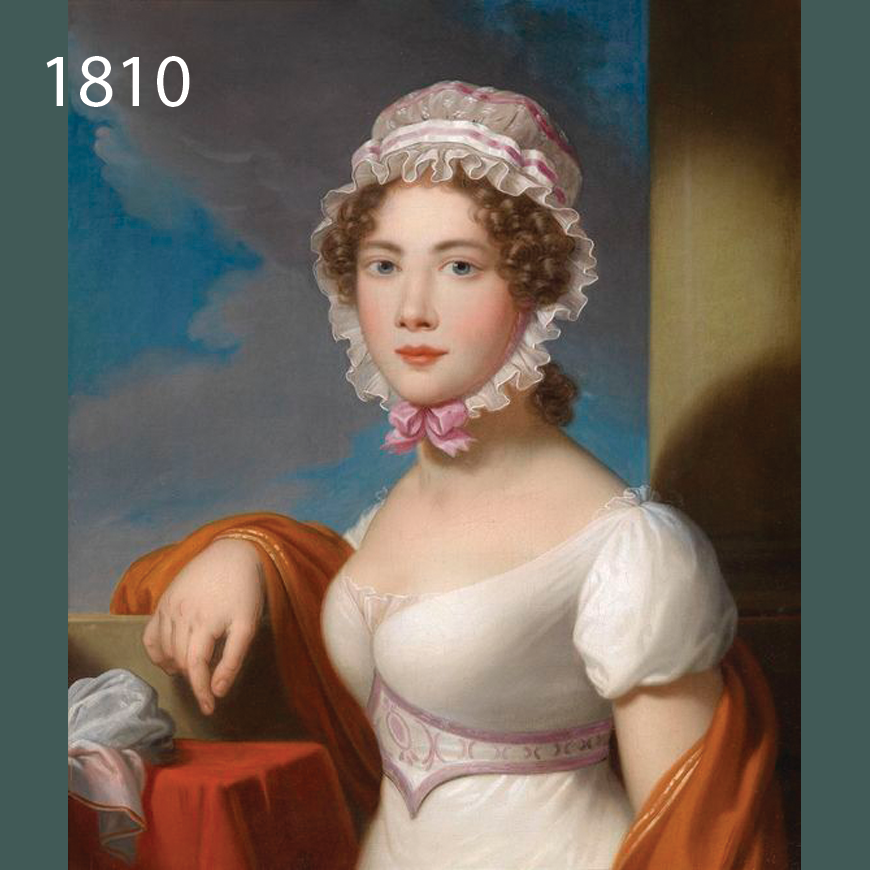
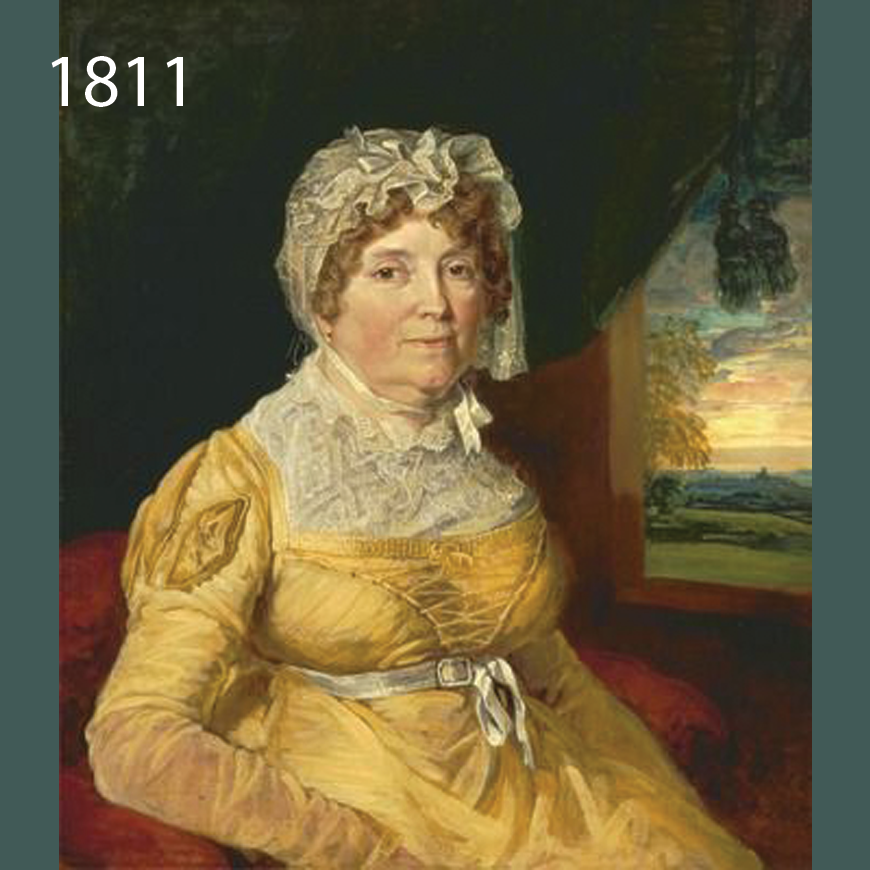
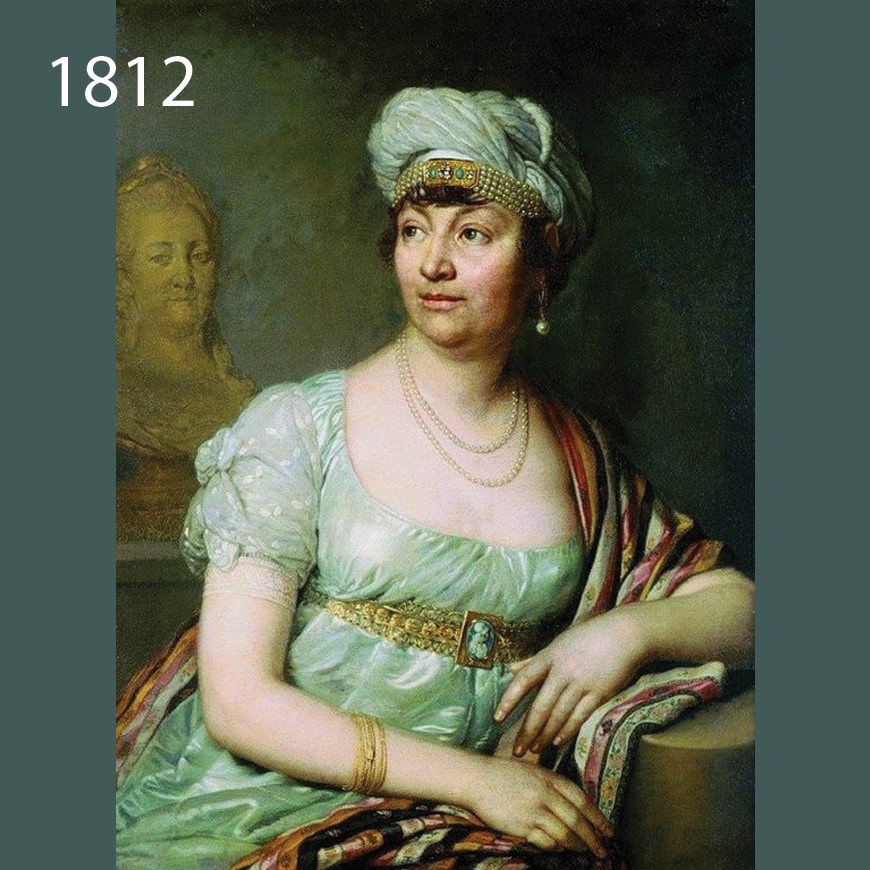
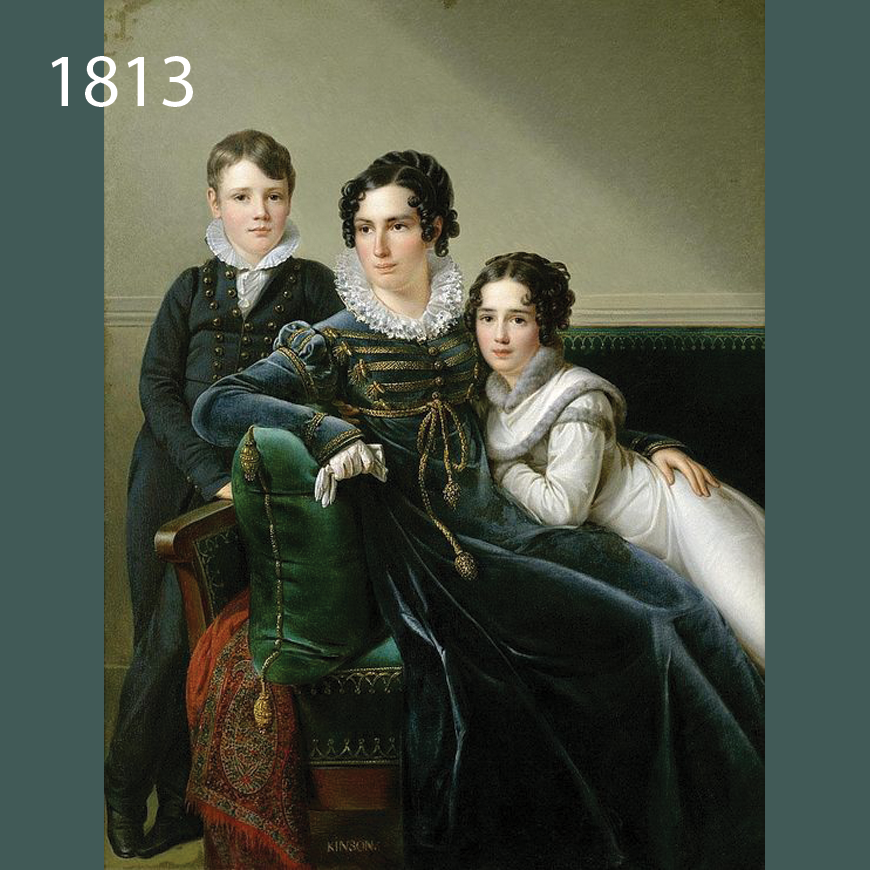
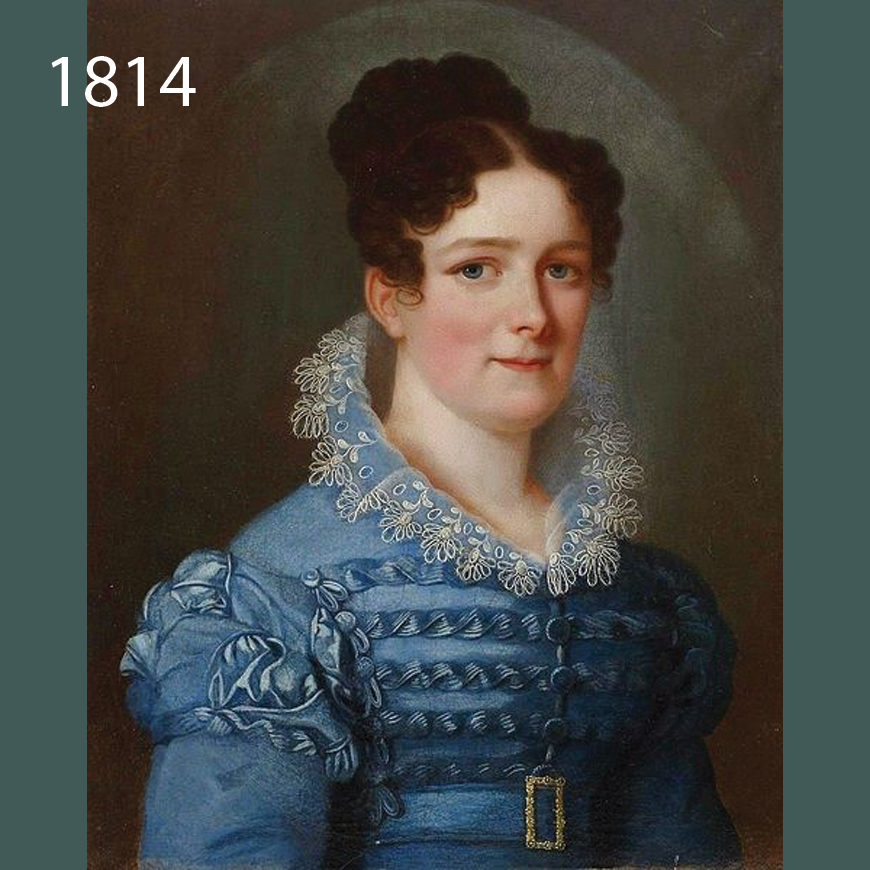
 —— WORLD SITUATION ——
—— WORLD SITUATION ——
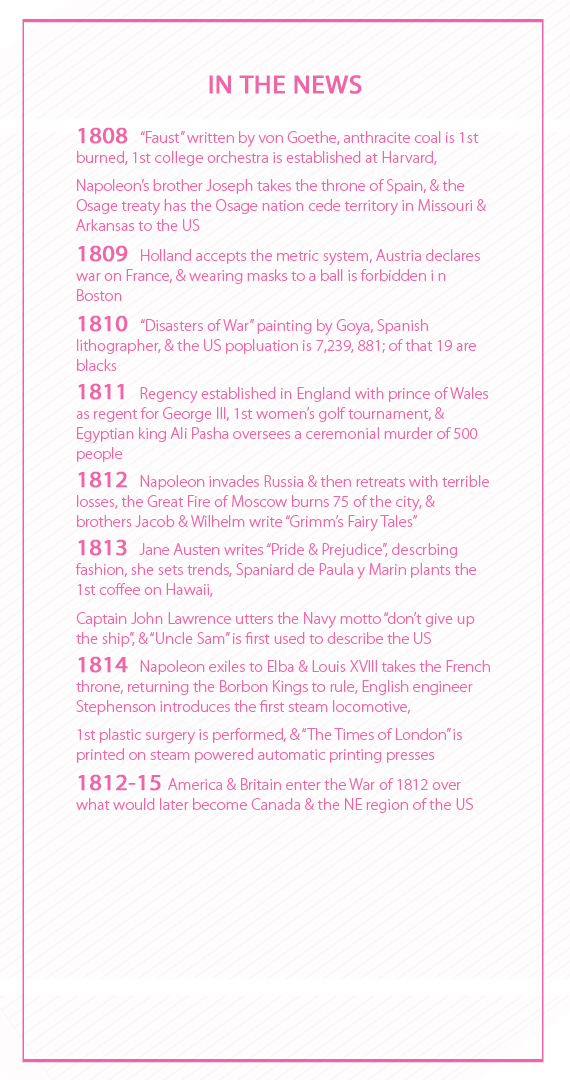
- 1799-1815 were the Napoleonic Wars in France
- Napoleon Bonaparte (crowned Emperor in 1804) would establish the French court again – removing the trend towards simplification that Marie Antoinette had started
- Napoleon’s new world Empire was to be one by creation of “unparalleled magnificence”
- Era is known as “Regency”, because the illness of King George II led to his banishment to an insane asylum. His son, George III, too young yet to reign, & with his father still alive, had England run by a Regent until the young king could take power. The time period between the two kings is the “Regency Era”
- The American War of 1812 vs Britain regarding Canada & the northeastern US territories, stopped all trade until its end in 1815
- There were many wars
- Most of the conflicts involved France, although there were power struggles in the Netherlands (Sweden, Denmark), the German territories, Prussia, & Austria
- Several countries declared independence from Spain, particularly those in South America
- Spain lost most of its empire, as America & other countries bought, or declared independent, sovereign states from among Spain’s holdings
- Key explorations were made of the continent of Australia
- In 1805 the Lewis & Clark Expedition, seeking a route to the Pacific across the new US territories, “discovered” the Rockies en route to Oregon
- Lewis & Clark opened the way to settlement by Russians later in the 1800’s in the territories of what would become Oregon & California
- America’s middle class continued to be strong & growing. It was made of tradesmen, merchants, farmer/planters, & industrialists
- Early 1800 trade changed Britain from a predominantly rural to urban society
- England had a “social season” when people came to town & stayed for specific purposes of socializing
- Wealthier people & a rising middle class split their time between country & city in England
- Provencial towns in Europe added opera halls & meeting houses to accommodate the upper classes traveling from city homes to summer estates
- Further developments included gaslights on London streets, steamships, steam powered locomotives, steam powered printing presses, & the first train lines laid in the United States
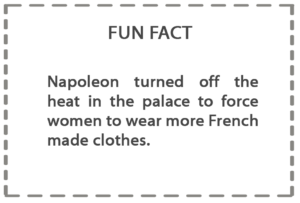

—— INTERESTING FACTS OF THE TIME ——
- Napoleon divorced Josephine (the leader of the Empire Regency fashion movement) in 1809, claiming she could not have children
- Josephine’s daughter through a first marriage would end up providing the heir to the throne
- Marie Louise was Napoleon’s 2nd wife. They married in 1810, & Marie Louise was at the height of her fashion influence in about 1814. Napoleon’s youngest sister Caroline made the match, & escorted Marie personally into France
- Marie was a quiet person whom the public thought “haughty”
- She was sent back & forth between countries to protect her from the various conflicts in which Napoleon was fighting
- She loved her tight circle of Parisienne friends best
- The new empress was not interested in fashion as Josephine had been, but allowed those around her to dress her as Napoleon saw fit, & therefore was considered “stylish”
- Napoleon hated the Regency style, although he was happy to see the corset reduced in usage & severity
- He had at one time forbid the wearing of the corset believing it caused infertility, but women ignored him
- Napoleon didn’t like the flimsy “robe en chemise” of Josephine’s “merveilleuse” days, or Marie Antionettes “gaulle” influence, so he made women add puffs at the shoulders, long narrow sleeves, & heavier silks
- Napoleon passed a law that no woman could wear the same dress to court twice
- In about 1808, Napoleon ordered courtiers to buy heavier fabrics & more ornamentation to boost the economy
- He turned off the heat in the palace to force women wear more clothes to Court
- To make sure women were wearing what he wanted them to be wearing, Napoleon mailed fashion dolls for courtiers to pattern their ensembles from
- Sending fashion dolls to nobility would continue to be the way to communicate fashion from this point until magazines became available later in the century

—— FASHION TRENDS ——
- Fashion still followed the French
- Torn by wars, the French themselves, & especially the bourgeois who funded the wars & supplied the military, could not afford the elaborate French fashions
- The French populace of all classes still preferred the simpler, less expensive English fashion of the Regency “little white dress” & variations
- The French did comply with Napoleon & modified the Regency style as ordered for Court.
- The flowing classical line of the early 1800’s was beginning to straighten & grow more angular as the soft, untrimmed muslins were replaced by firmer materials & the dress was stiffened by applied decoration
- These heavier gowns were decorated “a la conquering heroes” with military frogging, epaulettes, & braid
- Decorations were not enough to keep women warm, so they added fur lined garments with sleeves & hoods, creating the first overcoats as we know them today
- The pelisse crossed over eras from 1800 to 1850 as the covering for all the styles as they progressed
- From 1808 & especially into 1811 & 1812, there was a back & forth type of tug of war between Asian & Indian influenced garments
- Greek, Roman, & Egyptian influenced design was nearly out of style by now – although there was an 1807 Egyptian resurgence, & influence from Spain
- The new “Gothic Reform” was the result of merging:
- 1) the simple classical fashion the women wanted to wear
- 2) with clothing that was warmer & more practical
- 3) with Napoleon’s dictates to wear expensive entirely French made garments & lots of them
- 4) increasing desire to go back to the chivalry of the Middle Ages
- This nostalgia for “the good old Middle Ages” was in response to the constant unsettling feeling of always being at war, along with the confusion in class structure as countries reorganized, & the fear of new industrial developments that many felt was taking them further from who they felt they should be
- Each era from now forward would find something to look back on nostagically
- Ironically, this era would be looked fondly upon as an era of freedom from constraint with passion of conviction at the end of the Victorian Era in the late 1890’s
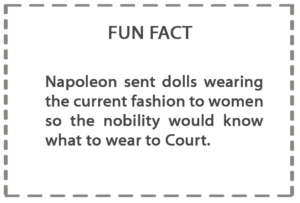

—— SPECIFIC FASHIONS ——
GOWNS
- By 1806, dresses did not have a train
- The gown was still based on the “little white dress” with the empire waistline, low decolletage, short corset, & flowing skirt, but it would make a huge transformation with each passing year
- The trend continually debased the straight classical line continuously until 1820 when the dress lost all classical form & became all Gothic line
- Sub-trends:
- 1800-1810, the gown was fastened by a front bib or apron which replaced the back closure of the previous Regency era
- 1808 : A quick stop, largely forced by Napoleon to add more cost & fabric for court wear; military with frogging, braid, & epaulets
- 1808: Spanish influence was introduced simultaneous to Napoleon’s edicts
- The ornamented sleeves & lace were introduced that would later take over as the dominant features to define the “Rococco” period coming up
- 1810: A mid point in definition of the gown. Up until 1810, the line of the skirt was still straight
- After 1810, the skirt flared, being cut of gores & pieces instead of a tubular piece of fabric
- The cut of the bodice began to settle down from the high empire waist to near the natural waistline
- The skirt was attached to the bodice across the back, & then slit either side
- Bodice fronts & backs were now mounted on a lining which had front flaps that pinned round the breasts to act as a kind of brassiere
- The front of the robe bodice was sewn to the front of the skirt with tapes attached at the waist
- For day wear, the bodice could be high to the neck, or have the low front filled by a “habit shirt” or “chemisette”
- 1811: Gothic reform (Middle Ages) changed the design far away from the “pure lines” of the first basic white dress
- started the trend to “Rococco” which was a more paneled & shaped skirt distinct from the top
- The Gothic inspired dress was cut much tighter & narrower than its predecessor
- Despite the tightness, a major change in construction (see below) made it more comfortable to wear than the looser gown of the recent years
- 1812: influence from India influenced fabrics, patterns, colors, & adornment especially
- With very little variation, two main types of construction at this point would be worn until the 1840’s:
- 1) If the front had no fullness, it was cut on the cross grain & fitted by two darts running from the point of each breast towards the center front
- 2) If the front was gathered or full, it was cut from the straight of the material & the fullness was evenly distributed around the neck. Gathers would then be drawn at the waist towards the center front
- For the first time in history, pieces of the gown were cut on the cross-grain
- Cutting with cross-grain allowed stretch so that the garment could cling very closely to the body, while still allowing free movement
- With very little variation, two main types of construction at this point would be worn until the 1840’s:
- From 1812 forward, cross-grain cutting was used on bodices to give the bust a “well rounded” shape
SLEEVES
- Sleeves in particular were cut on the cross-grain, copying men’s breeches which had been cut so for over a decade with great success in bending the knee. In the same way, the elbow could be accommodated
- Throughout the era, sleeves varied from 3 types:
- 1) a short puff cut on the cross grain
- 2) a puff worn over a long sleeve
- 3) a long sleeve which might be caught in puffs down the arm
- Sleeves, long or short, were fuller in this era than the previous Regency periods
- An over-sleeve was common
DECORATION
- Ornamentation from 1810 forward added Elizabethan ruffs at the neck & VanDyke collars (which pointed & crossed over the bodice)
- The “Middle Age” Tudor influence was replicated using copious trimmings, flounces, pleats, tucks, sleeves, sashes, & hems to create an extremely ornate look
- By 1820 this Tudor look was the universal Regency look, & carried to the end of Regency in 1824-25
UNDERGARMENTS
- Women wore no petticoats at first
- As the era progressed, a matching conical shaped petticoat with flounce at the bottom was used. This would be a stiff bodied fabric to maintain the shape of the skirt
- Stays were relatively the same throughout the Regency era
- Stays also dropped lower to accommodate the lowering waistline
- Stays still did not give structure, but were basically there to support the breast & hide the figure if needed
- Stays were more for modesty than shaping
OUTERWEAR
- Shawls were very popular to cover a bare & cold breast
- In 1812-13, one of Scotland’s major exports was plaid shawls, a name which also applied to kilts, trews, & many other types of outer wear the Scots sold worldwide (Kilts, trews, & plaids a fashion Queen Victoria would later admire & emulate)
- “Paisley”, a regional location from which a particular pattern was developed, became the name of the style & for a shawl in general
- Lower classes in England relied solely on shawls for warmth
- Shawls for the lower classes were made of any woven material available, but were predominantly wool
- Middle class shawls were worn for warmth
- Upper classes had cashmere, cottons, silks, & imported fabrics. They wore shawls as fashion statements as well as for warmth
- Fancy shawls were imported from the East, & had many varieties & price
- Indian shawls were of special importance as they introduced complex weaves & unique Eastern flare
- Shawls were easily mass produced because the simple woven rectangles & squares were easy to make on early industrial weaving & spinning machines
- The “Bosom Friend” was also worn as a “tippet” to cover the throat
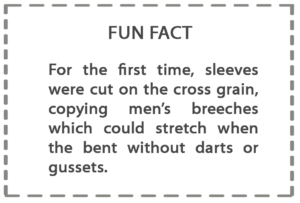

—— GARMENTS FROM ERA ——
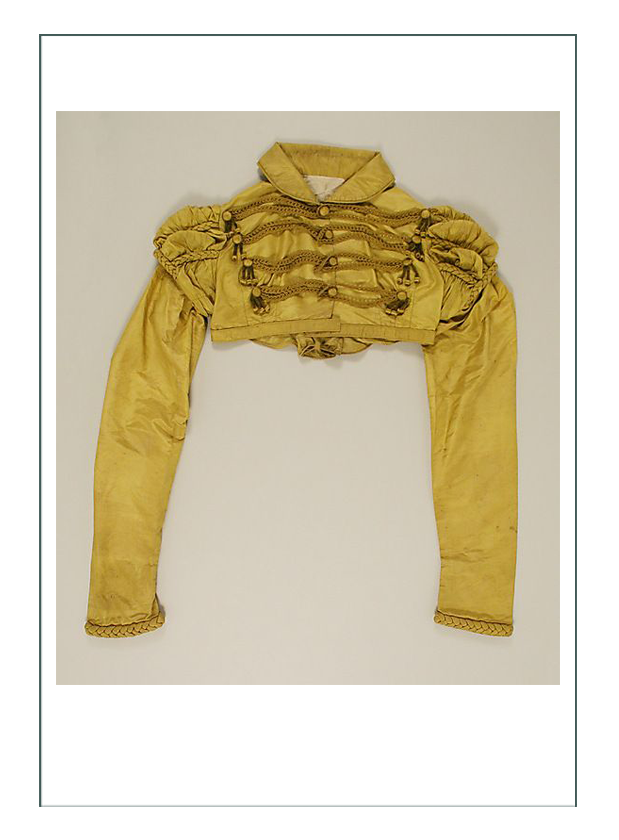
—— (above) “High Waist Spencer Jacket w/Frogging 1808” ——
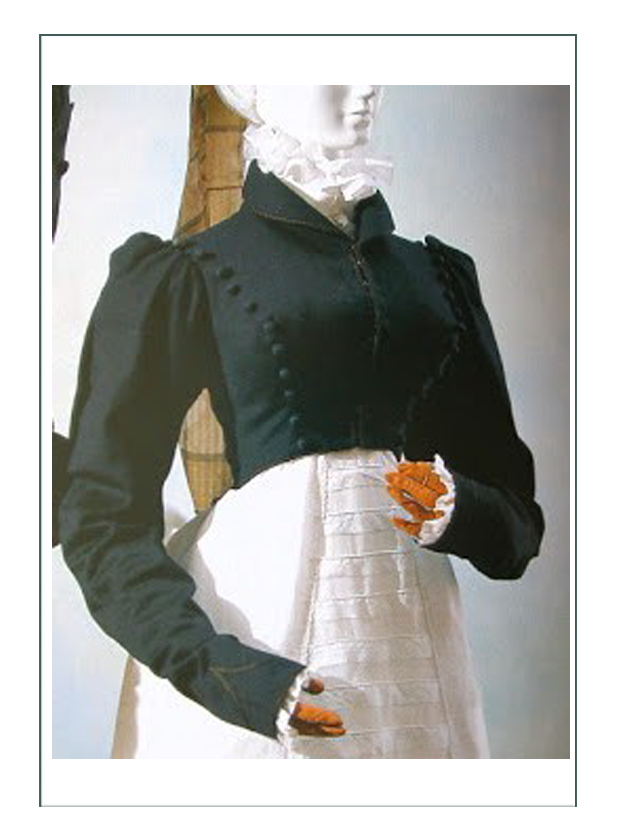
—— (above) “Rib High Spencer Jacket 1808” ——
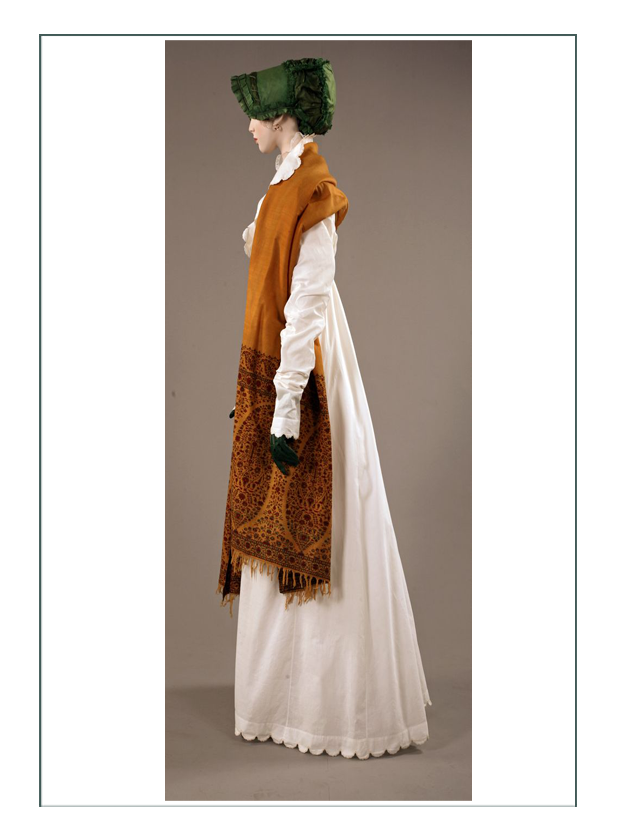
—— (above) “Redingote with Cashmere Shawl 1808” ——
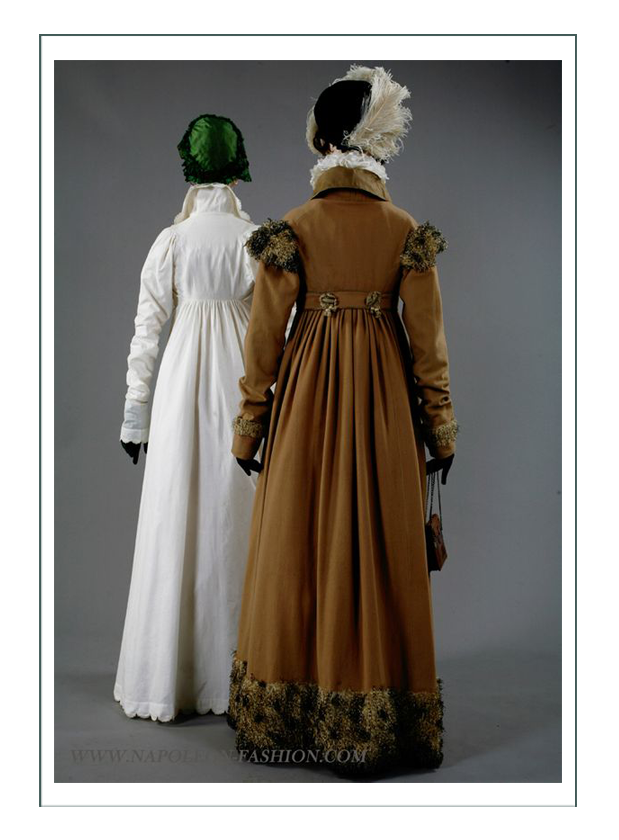
—— (above) “Redingote 1808 (left); Pelisse 1809 (right)” ——
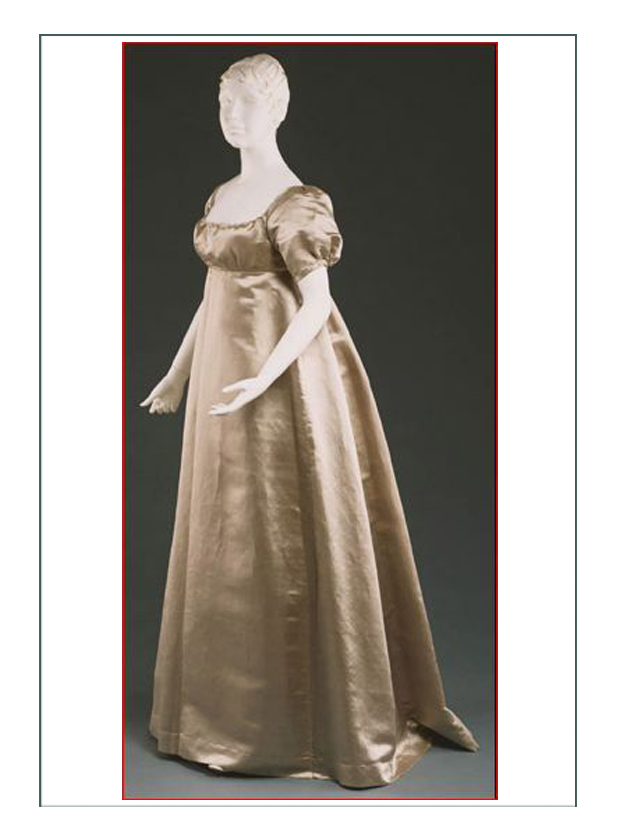
—— (above) “Silk Evening Gown 1809” ——
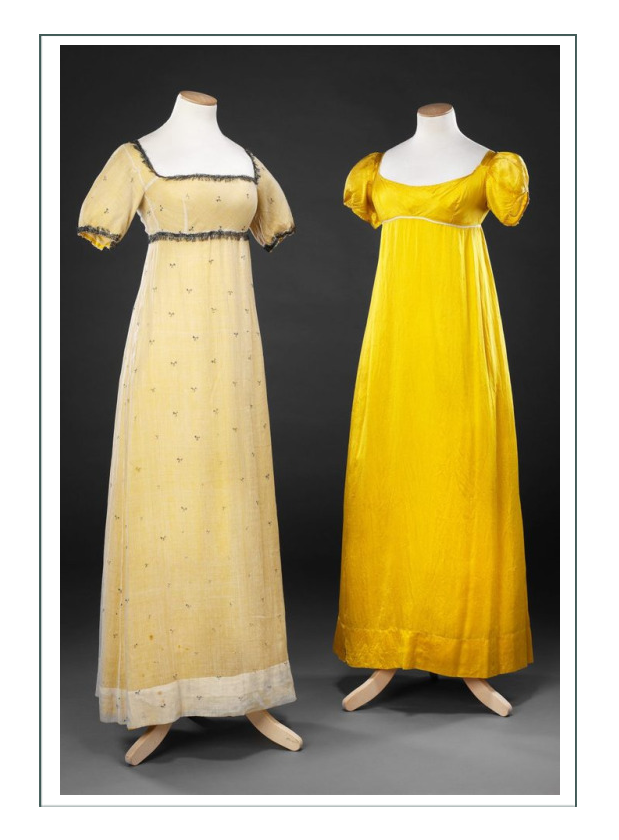
—— (above) “Day & Evening Gowns for Maidens 1810” ——
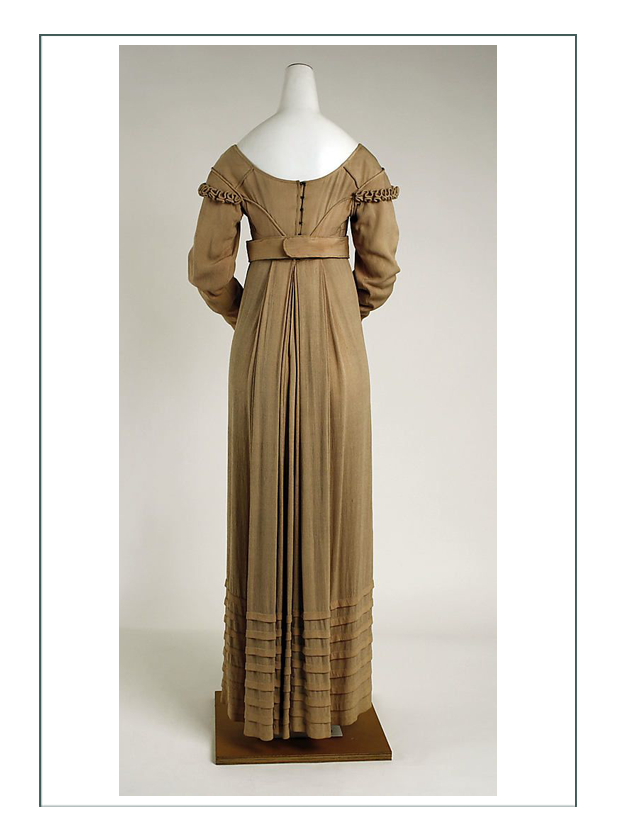
—— (above) “Traveling Gown 1810” ——
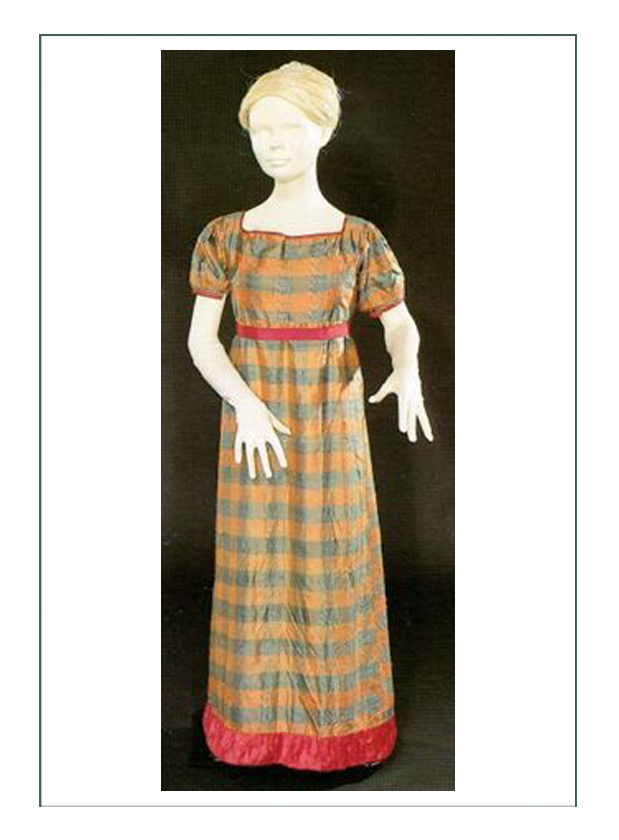
—— (above) “Youth Gown from Portugal 1810” ——
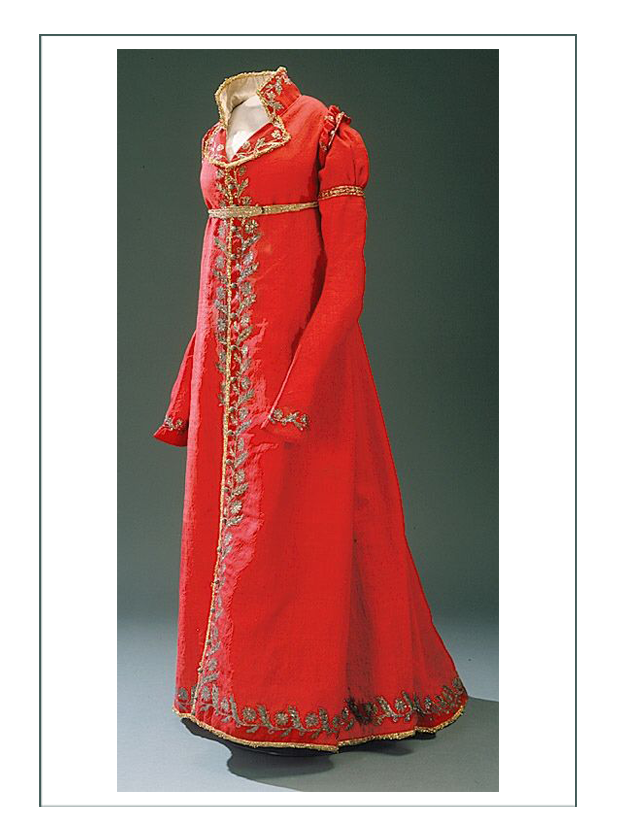
—— (above) “Redingote 1810” ——
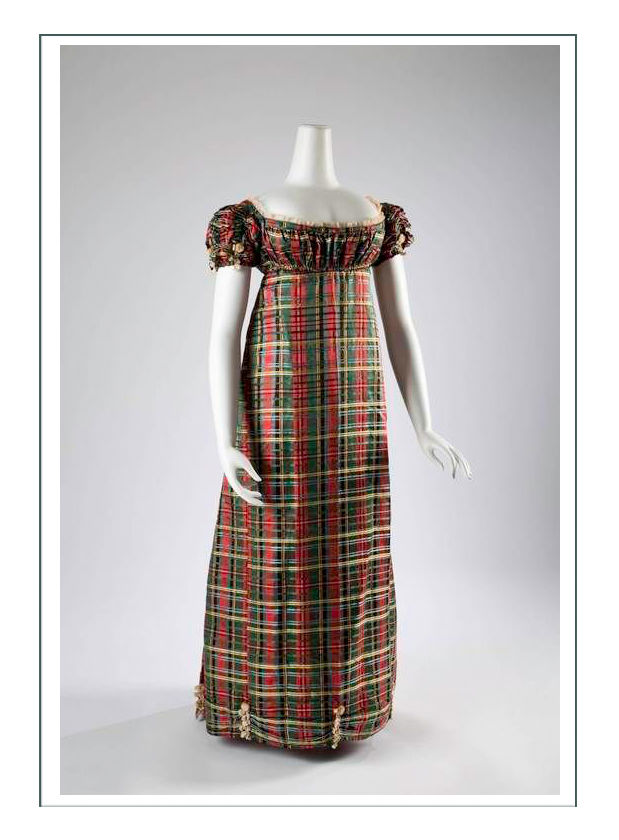
—— (above) “Silk Tartan Gown 1812” ——
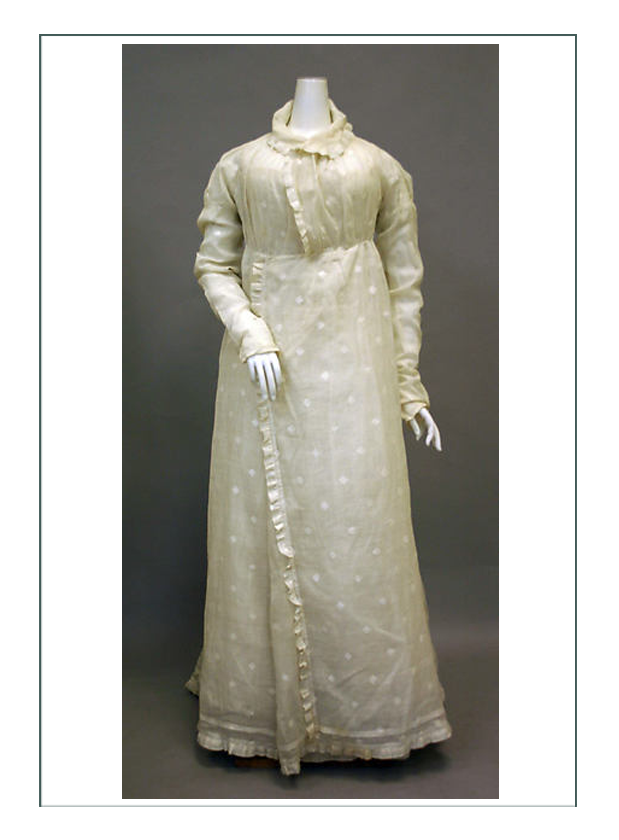
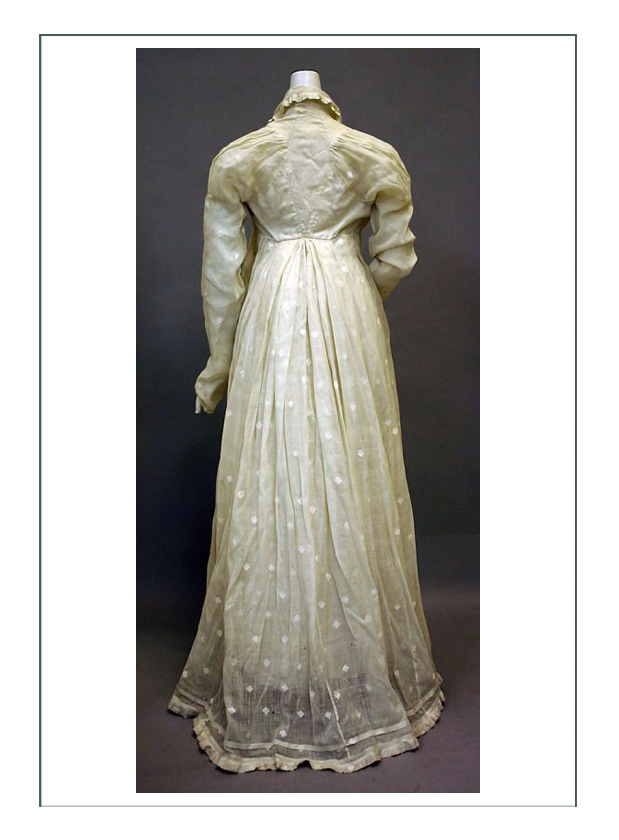
(above) “Morning Gown Front & Back 1814” ——
Click to go back to top of page
Click date below to go to a different era. We can replicate most ANY garment you see!
